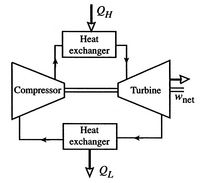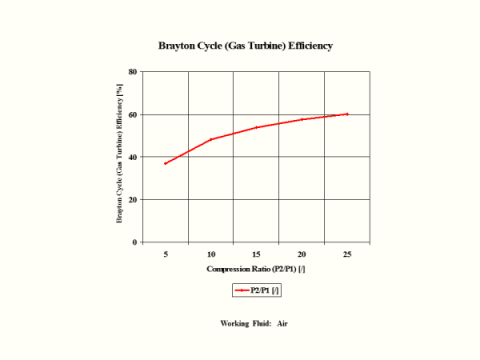

In this diagram, we see that there are 8 processses to describe the Brayton cycle in terms of temperature, entropy, and pressure.

There are turbines right in front of the expansion chamber that is connected to the turbins in the compression chamber so the whole engine is a continuous cycle as long as there is a steady stream of fuel being introduced into the combustion chamber. Enough the air is compressed enough in the middle of the engine (the combustion vessel), fuel is added to the combustion chamber and an ignition is initiated, where the extremely exothermic reaction causes the gas to violently exits the engine in the expansion chamber in the back of the engine. At the front of the engine is the inlet of the compression chamber so that air is sucked in by the many turbines that are constantly spinning and angled in a specific location for optimum air compression. This is one of the many modern day gas turbine engines that utilize the Brayton Cycle in order to power many vehicles or generate power. federal government, the image is in the public domain. This image is from: As a work of the U.S. This 480-megawatt unit has a rated thermal efficiency of 60% in combined cycle configurations.
#Net workdone in brayton cycle series#
Modern Day Jet Gas Turbine Figure 1:GE H series power generation gas turbine. This would release the pressurized gas to a combustion vessel, which would turn pistons to create mechanical work and re-compress the gas in the reservoir. The design was a engine connected to a reservoir of pressurized atmospheric air and gas which would only turn on if a valve was turned. George Brayton was an engineer that designed the first continuous ignition combustion engine which was a two-stroke engine that was sold under the name "Brayton's Ready Motors." The design employed the thermodynamic processes that is now considered "The Brayton Cycle," but is also coined The Joule Cycle. However, because back in the late 18th century there was lack of technological advances and such, the gas turbine did not have enough energy to pressurize the gases and do useful work at the same time therefore it was not used. Once the air has mixed with the fuel and reacted, the energy from the combustion would be used to spin a turbine to do useful work. The idea of the machine was to compress atmospheric air in one chamber and fuel in another chamber and both chambers would be connected to a combustion vessel. The first gas turbine that implemented the Brayton Cycle (not knowingly however, because it was created before the Brayton Cycle was even established) was John Barber's gas turbine patented in 1791. The usefulness of the Brayton Cycle is tremendous due to the fact it is the backbone in driving many vehicles such as jets, helicopters, and even submarines. The most basic steps in extracting energy is compression of flowing air, combustion, and then expansion of that air to create work and also power the compression at the same time. The idea behind the Brayton Cycle is to extract energy from flowing air and fuel to generate usuable work which can be used to power many vehicles by giving them thrust.

The Brayton Cycle is a thermodynamic cycle that describes how gas turbines operate.


 0 kommentar(er)
0 kommentar(er)
